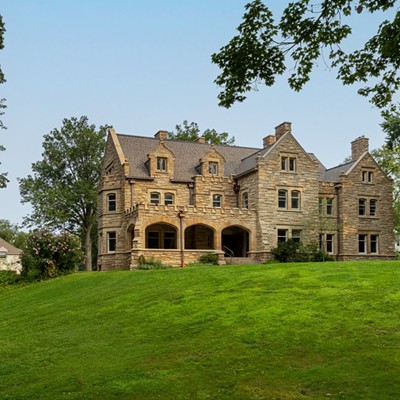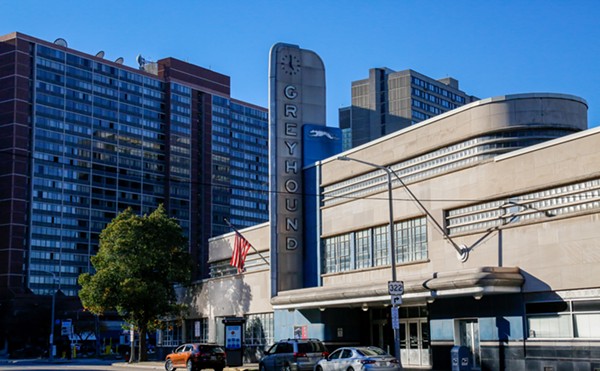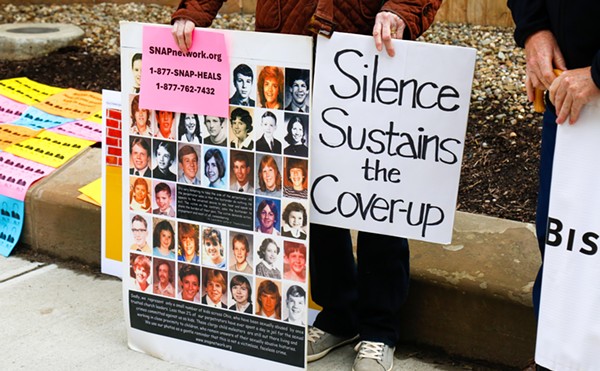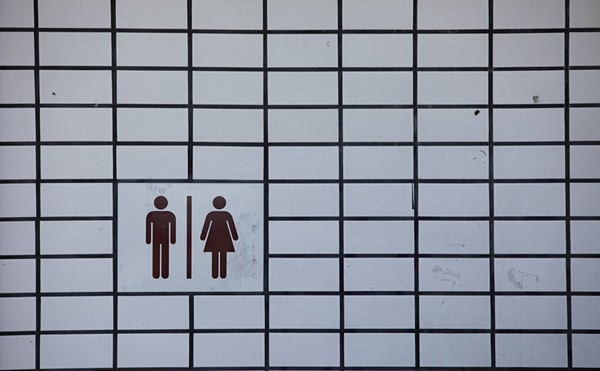Though not her five children's biological mother (their genes belong to a wayward goddaughter), Kitchen is an active parent. Teachers and principals come to know her quickly. On a visit to the school, she asked about the broken arm, expecting an explanation that involved a patch of ice. Instead, she learned her daughter's version was true: A student had assaulted a teacher.
The incident was one in a string that convinced Kitchen to remove her kids from Cleveland schools. She speaks of textbook shortages, halls reverberating with chaos, and principals functioning more as prison wardens than educators. Her oldest daughter was in sixth grade, but couldn't read. Outside the school, drugs clogged the Collinwood neighborhood.
"I just had to get them out of there," Kitchen says.
The oldest is now 20. A son and a daughter attend Lutheran East High School. Kitchen, a bookkeeper at the Eaton Corporation, home-schools a 13-year-old in the mornings and after work. Her youngest, a 10-year-old daughter, attends a parochial school on a voucher.
The Cleveland Scholarship Program was established in 1997 to give parents like Kitchen, bound by address and income, an opportunity to better their children's education. The voucher covers only a part of her youngest's tuition, but without it, "There's no way I could have continued," Kitchen says. "It kept me from having a nervous breakdown."
Voucher proponents raise Kitchen as a compelling argument for school choice. But though the subsidized flight from downtrodden Cleveland schools gets most of the ink, vouchers are only a small piece of the pie taxpayers leave cooling on the windowsill for private schools. This year the state appropriated $211 million for those who opt out of the public system. Even students at tony Andrews School -- where horse riding along the Chagrin River is a focus of the curriculum -- are subsidized by taxpayers.
"Just because a parent chooses to send their child to a private school doesn't mean they lose any right to a public education," says state Representative Jamie Callender (R-Willowick), chair of the House Education Committee.
Private school boosters contend the money pays for things the state mandates. And they say Ohio is getting a bargain, since the state would spend an average of $3,000 annually per pupil if these same kids attended public schools. "We're doing a service," St. Ignatius Principal Richard Clark says. "We're teaching a certain number of kids who would be in the public schools the state has to pay for."
True. But there remains the question of why the state is funding private schools in the first place. Philosophical arguments aside, it's a matter of dollars and cents. Twice the Ohio Supreme Court has found the state guilty of failing to provide a "thorough and efficient system of common schools." In September, after a 10-year legal battle, the court ruled that the legislature's latest plan was constitutional only if the state came up with hundreds of millions more. So while legislators bray about declining revenues, budget shortfalls, and the possibility of tax hikes, they nonetheless maintain the nation's most lavish private school welfare system. To critics, they're akin to the man who insists he must keep his Lincoln, even though his mortgage is three months past due.
"If the state wants to expand its role into private education, that's OK," says William Phillis, director of the Coalition for Equity & Adequacy of School Funding -- the group that brought a school-funding suit. "But it's kind of an irony that Ohio is considered among the first in private school funding in the nation, and we're considered among the worst in public school facilities."
In a blissful section of Shaker Heights, some 670 students attend Laurel School, which touts itself as "the best place for a girl to learn." There's little reason to doubt the claim. Students at the 105-year-old institution enjoy amenities that include three art studios, a photography lab, two indoor gyms, and a dance studio. The new library will feature 234 data ports. Laurel recently purchased 140 nearby acres for athletic facilities and outdoor education.
And the school collects $278,000 a year from Ohio taxpayers.
The money is paid through a subsidy known as "auxiliary services," which provides about $490 per student for textbooks, guidance counseling, nursing services, computer software, and a host of other expenses. The state drops the money on a stump for all private schools, be they St. Joseph Elementary in Collinwood, where four in five students are eligible for free and reduced lunches, or University School in Hunting Valley, which has a $64 million endowment.
Karin O'Neil, director of the Ohio Association of Independent Schools, which represents the Laurels and Hawkens of the state, sounds almost embarrassed by the subsidies. "Certainly none of the schools in the association would have sought this . . . This is one of those things where blanket legislation scoops up a lot of things as it goes along."
Per pupil, $490 may not sound like much, but with approximately 240,000 children attending private schools, the subsidy cost Ohio $118 million this year. The state also helps with busing, paperwork, teacher training, Internet access, and mobile classrooms. The Catholic Diocese of Cleveland figures it will receive $53 million from the state in addition to the $13.9 million appropriated for vouchers.
"The legislators realize the outstanding job our principals are doing," says Mike Voinovich, the diocese's government director. "That's why they support our programs."
That a Voinovich works for the church shouldn't surprise those who follow Ohio politics: The diocese had no greater friend in Columbus than Mike's brother George during his two terms as governor. "Fortunately for non-public school parents, gubernatorial administrations and the General Assembly in Ohio have been sympathetic with and attentive to the needs of non-public school children," David J. Young, legal counsel to the Catholic Conference of Ohio, once wrote. "We owe a debt of gratitude to our elected representatives, because this amount far exceeds assistance to non-public school pupils in any other state in the Union."
Voinovich was a stout supporter of parochial schools. He bragged to bishops in 1993 that they could expect a greater increase in state funding than some public schools, according to a 1999 Akron Beacon Journal series. It wasn't enough. The Cleveland diocese later complained to Voinovich about the $1.2 million it cost to keep open its inner-city schools. Vouchers were part of the rescue package, says Richard DeColibus, head of the Cleveland Teachers Union. "George Voinovich and Bishop Pilla got together and said, 'How do we prop up these inner-city schools?'"
More help followed. In 1994 the Catholic Conference asked Voinovich to raise the "administrative cost reimbursement" -- aid private schools receive for various clerical matters -- from $78 per pupil to $147.40. Voinovich's next budget delivered the exact amount -- nearly a 100 percent increase.
The former governor also steered private schools a subsidy that doesn't appear in any line item. In 1994 Ameritech offered an $18 million technology pot for schools if the utility commission eased regulation. Over six years, $1.9 million has gone to private schools for Internet hookups.
"We're educating the boys and girls," Mike Voinovich says. "They're becoming productive citizens in the community."
Few dispute that. But what of the children in Ohio's charter schools, which Governor Voinovich also championed? Aside from a few success stories, like the Old Brooklyn Montessori School, the experiment is proving an embarrassment of low test scores and dubious motivations. The Cleveland Learning Academy on the East Side, operated by a for-profit company in Maryland, finished its second year with a mostly uncertified teaching staff begging for pay and classrooms wanting for books and supplies. Nonetheless, a current House bill promotes expanding the program -- while simultaneously shielding from the public records of the companies that operate the schools.
"My brother George has been supportive of all education!" Mike Voinovich says, rapping the table for emphasis. "All education!"
But public schools, particularly the poor and the rural, saw George another way: as negligent. So they banded together to sue the state, claiming the system was so reliant on property taxes that only the suburban districts could thrive.
"He sold the public schools down the river," says DeColibus.
Bob Mooney, a father of three, sits on the board of Magnificat High and is a former board chairman at St. Ignatius, where his youngest is a junior. His business is investing, and he believes the efficiencies of capitalism can be applied to education. "I think the more market systems you can bring into the system, the better off you're going to be."
Private school parents and administrators justify the subsidies with a range of arguments. The market approach is one. Another suggests entitlement. "The parents of these children are taxpayers, and this is somewhat of a return on their dollars," Catholic Conference Executive Director Timothy Luckhaupt says.
Adds state Representative Callender: "There's a thought in Columbus among a lot of people that it's fundamentally unfair to ask somebody to pay for something twice, to pay for your child's education two times. We're trying to do what we can so that someone who chooses private school is not penalized for doing that. That's the theory; shoot holes in it if you want."
And shoot critics do. Phillis, who sits on the board of Village Christian School in southwestern Ohio, says subsidizing families who opt out of the system is akin to assisting a country-club member with his dues, since he's not using the city park. "So does that mean, if you don't have kids, you should get a rebate? We can carry this thing to a ridiculous end, where everybody figures out the services they don't use and either expects a rebate or a subsidization."
"When you go into a community, you pay for a host of services, whether you consume them or not," says Andrew Benson, president of the New Ohio Institute, an education think tank based in Toledo. He's written that vouchers are undemocratic, a confiscation of taxpayer will into the shopping carts of a few parents. "You know who pays for our schools? Businesses, the elderly, people with no kids, visitors to the area."
Benson also rejects the mandate defense, which says private schools are being paid to do what the state requires, such as take attendance and chart student progress. "Those minutes add up," says Maggie Lynch, principal at Villa Angela-St. Joseph High School. But the government, Benson says, demands all sorts of things without paying for them. "I run a nonprofit. I have to take the time to withhold the payroll taxes of my employees. Does the government pay me?"
Public school districts have an unfunded-mandate defense of their own. By law, they have to provide transportation to all pupils, regardless of where they go to school. Cleveland schools spokesman Alan Seifullah says it costs $12 million a year to bus private school and charter school kids around, but the district doesn't receive the commensurate funds.
Private schools do save taxpayers money by educating a load of students who otherwise would attend public schools. Nuns, after all, don't cash checks from the state retirement system. But public-education officials say the savings are not near the $1.5 billion claimed by the Catholic Conference. While a number of parochial schools in the city of Cleveland serve students from families of low means, for the most part private schools cream students that are less expensive to educate. Besides the obvious funnels, like tuition and entrance exams, privates manage their enrollments in more subtle ways, according to Valerie Federico, president of the Ohio PTA.
The auxiliary services subsidy, for instance, provides money for remedial and handicapped students. Federico says private schools collect payments while fending off the really expensive kids. The parent of a special-needs child, she argues, will quickly grasp that the desired services and facilities are not offered at a private school. "Let's be honest, when they're really denying a lot of disabled children. We accept them all."
The subsidies don't end at the hemlines of plaid skirts in primary and secondary schools. This year Ohio gave $99 million to students who attend private colleges and universities. Some of the scholarships go to students who excel academically or come from disadvantaged homes. But more than half of the money -- $51 million -- is paid without regard for need or merit. Any resident who attends an Ohio private college full-time is eligible for a Student Choice Grant of $1,062 a year, so the state ends up rewarding C students from wealthy homes the same as it would honor students from East Cleveland.
Cleveland State Vice President of Finance and former state legislator Roy Ray calls the choice grants "a handout" few people know about it, let alone debate.
Meantime, public colleges and universities are jacking their tuition at rates between 7 and 10 percent a year, thanks to higher-education budget cuts. In 1987, state money constituted 66 percent of Ohio State University's operating revenue. The percentage this year is 49 percent, forcing students, parents, and alumni to make up the difference. Last year the National Center for Public Policy and Higher Education graded Ohio's college affordability a D-minus.
Larry Christman, director of the Association of Independent Colleges and Universities of Ohio, says the state underfunds private and public higher education alike. He defends the Choice Grants as a means to keep Ohio students in Ohio. Besides, he adds, the state doesn't means-test families who choose public universities. "Essentially our problem is, we're a low-tax state overall," Christman says. "And if you're a very low-tax state, you can't be a very high-expenditure state."
Christman and other education lobbyists at times find talking to legislators a bit like trying to explain the international date line to a five-year-old. State Representative Chuck Calvert (R-Medina), a member of the House Education Committee, agrees that college tuition is too high -- but don't tell him Ohio is a low-tax state. "We're one of the highest-taxed states in the nation," he says. He points to information from the Buckeye Institute, a conservative think tank. But according to the U.S. Census Bureau, Ohio ranks 34th in total taxes per capita.
But tax increases are not to be spoken of at the Statehouse. In September, Senate President Richard Finan (R-Evendale) was asked where the state would find the $1.2 billion needed to comply with the school-funding order. "I say, let the court figure it out," he sniffed to reporters.
Rocky River Drive in West Park is a tumble of white shirts, navy shorts, and backpacks. Under a postcard-blue sky, Diane Jablonske turns home after escorting her grandkids to Our Lady of Angels elementary.
Jablonske's morning stroll, it could be said, was 25 years in the making. In 1976, federal Judge Frank J. Battisti found the state and Cleveland liable for maintaining a racially segregated school system. Among the remedies, Battisti ordered cross-town busing. The ruling drove thousands of parents to the suburbs and private schools. "They ruined it with busing," Jablonske says. "We wanted our kids in neighborhood schools."
There were other sins. From 1978 to 1995, the district went through eight superintendents. One, Frederick D. Holliday, killed himself. A letter he left behind admonished the board for letting politics shroud education. Federal Judge Robert B. Krupansky called Cleveland schools "a rudderless ship mired in mismanagement, indecision, and fiscal irresponsibility," and ordered the state to take control.
Jablonske sent her children to parochial schools; now her grandchildren attend. In predominantly white, deeply Catholic, affluent-by-Cleveland-standards Kamm's Corners, Jablonske's story could be told from countless porches. Cleveland's enrollment is half of what it was in 1965.
"I can't send my kids to the Cleveland public schools," says an Our Lady of Angels mom. "They're terrible." She wants the Cleveland schools rebuilt from scratch. "All those teachers have no manners and no class. If they did, they would leave within three months."
But what bothers public-education advocates is how the state seems comfortable with a system in which it's every family for itself. It's as if the state woke up 10 years ago, discovered its poorer public schools a mess, and decided to put its money elsewhere, leaving the underfunded remains to rot. "There are some public school systems that are allowing too many children to fall through the cracks," says Callender. "And if you're a parent who lives in one of those school districts, you have an absolute right and maybe even a duty to see to it that your child does get a good education. If that means a private school, then that means a private school."
Which leaves large urban districts with parents who don't have the means or sophistication to escape. In Cleveland, 43 percent of families with children live at or below the poverty level -- conditions not exactly ideal for proficiency-test scoring. Yet that's how schools are judged. Some educators say testing is less a measure of student progress than a means to humiliate public schools and bless market reforms. DeColibus is led to believe an element in the Statehouse "wants to destroy the public school system in Ohio." The words of a union dramatist, maybe, but even decorous observers sense an indifference that borders on hostility. "It's unfortunate, but I think some legislators have just given up on the Clevelands of the country," says Warren Russell, legislative director of the Ohio School Boards Association.
House Education Committee member Bryan Flannery (D-Lakewood) favors mandated-service subsidies for private schools; he also sees lawmakers who'd rather punish struggling publics than deal with their problems. "There's a mindset that says, 'In order to be tough, we have to threaten the kids, the parents, and the schools,'" Flannery says. "It's kind of like 'We'll show you.'"
| 2001 Appropriations for Chartered Non-Public Schools | |
|
Auxiliary services
Administrative cost reimbursement Transportation Vouchers Connectivity Mobile classrooms Post-secondary enrollment Total |
$118,083,309
51,474,714 21,000,000 13,900,000 4,500,000 1,328,910 1,000,000 $211,286,933 |
| 242,630 non-public schoolchildren = $870 state subsidy per child | |











